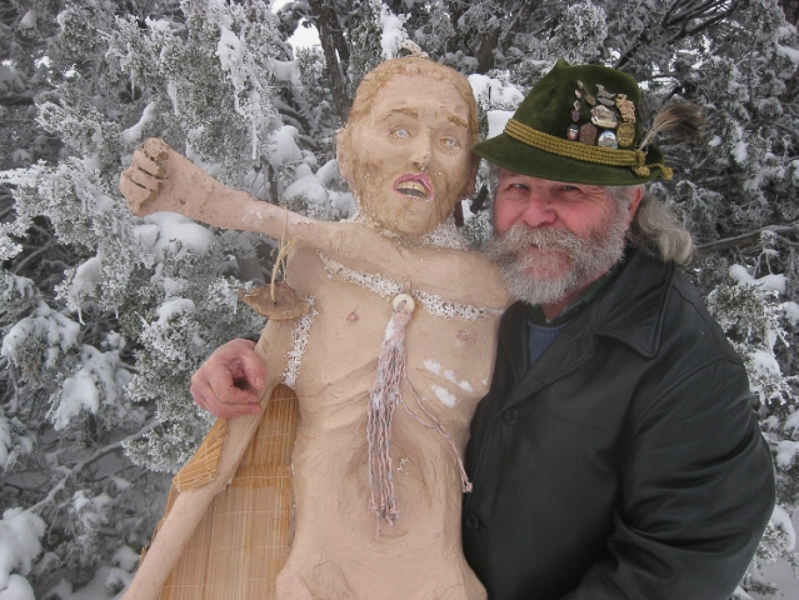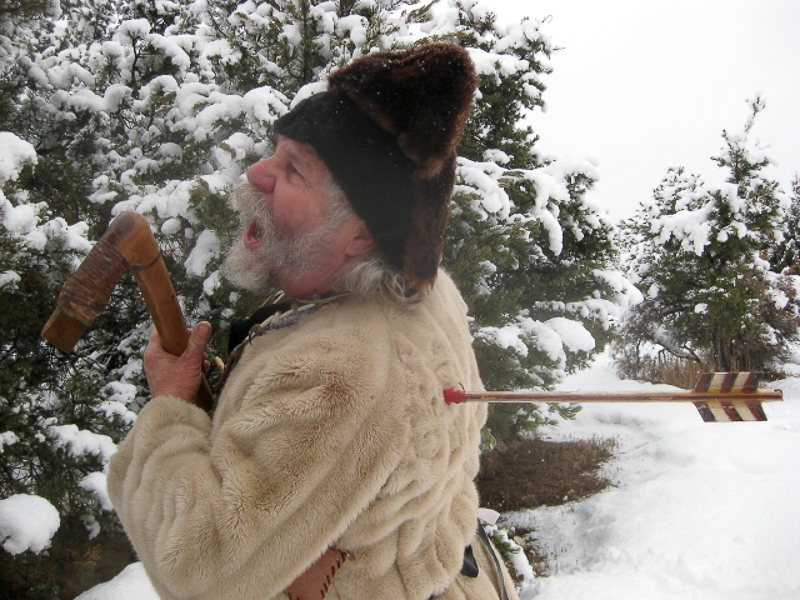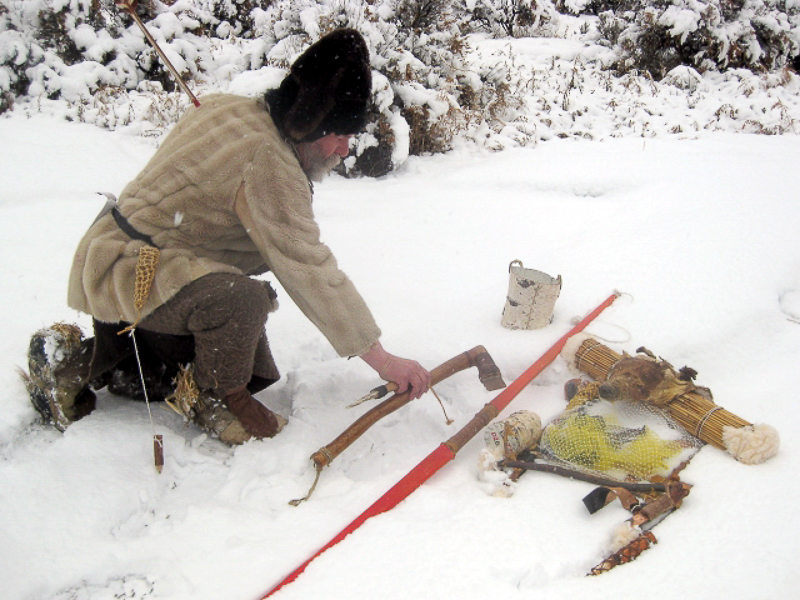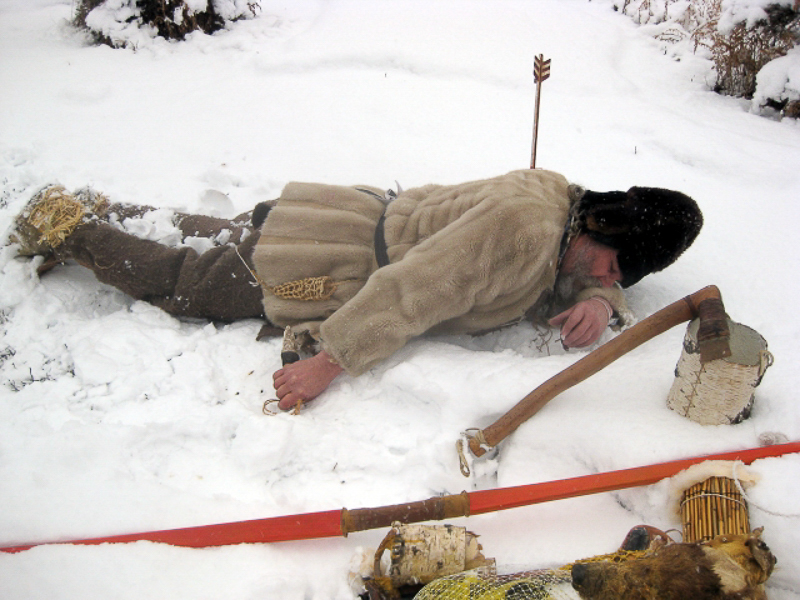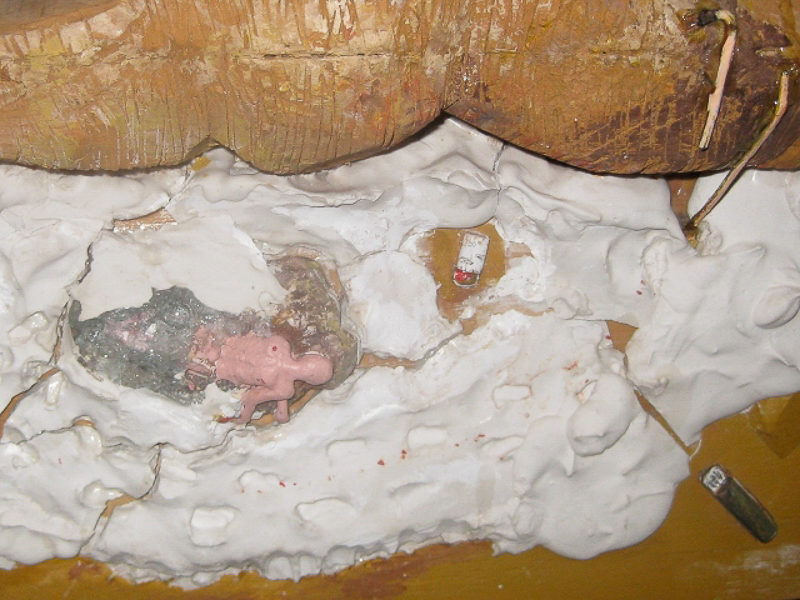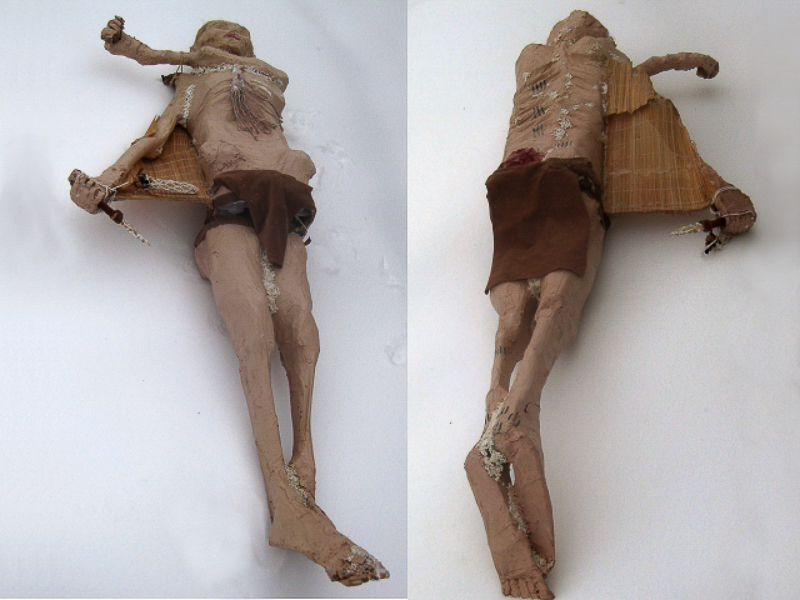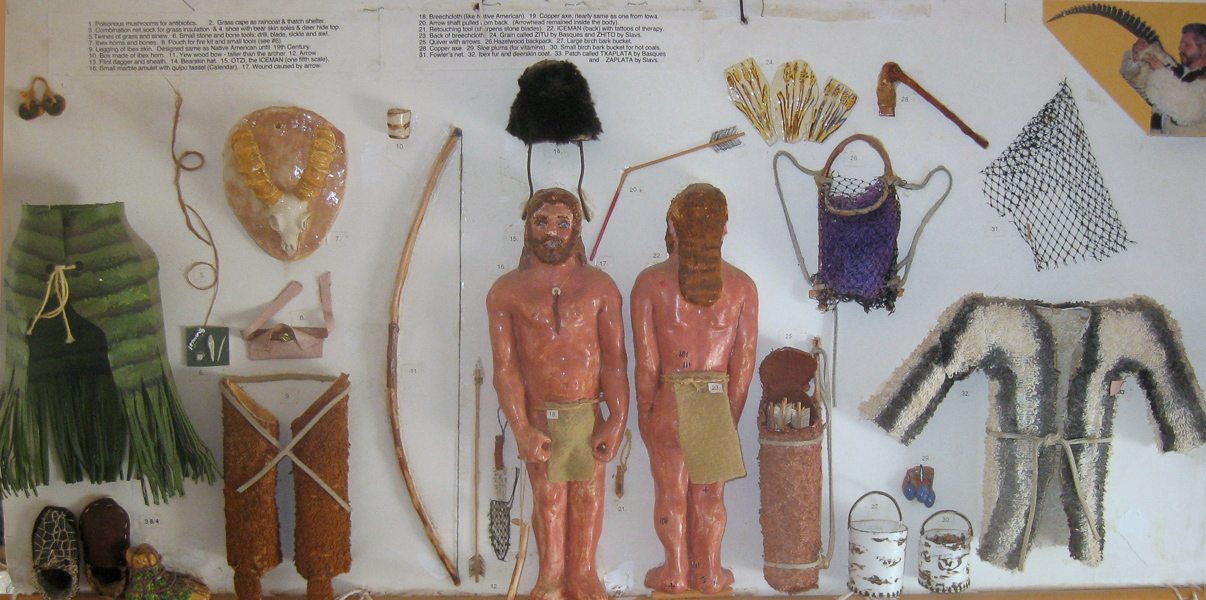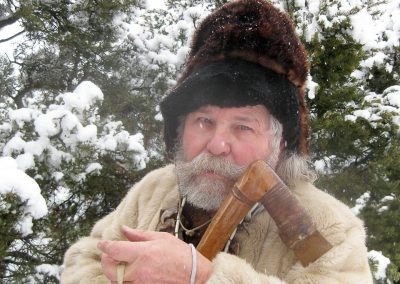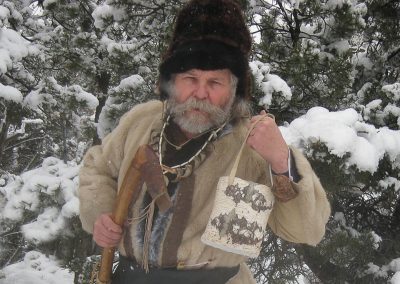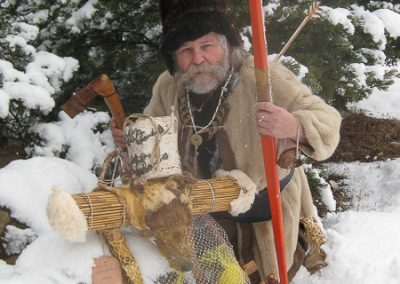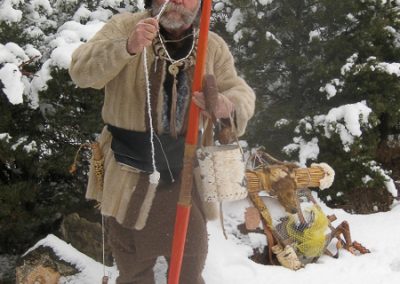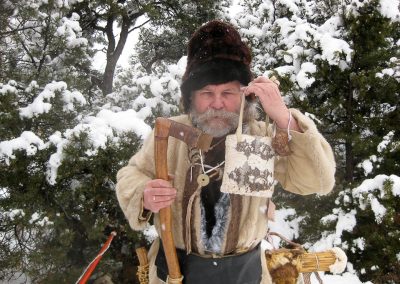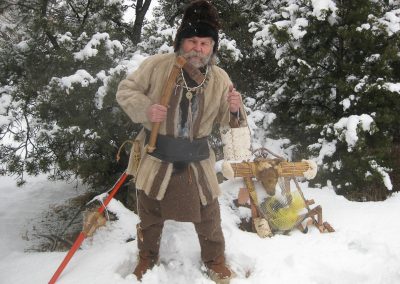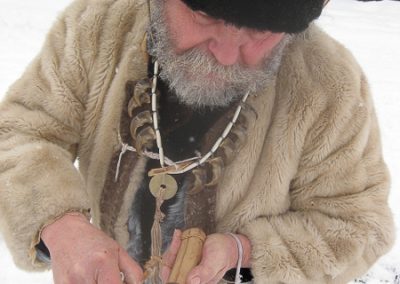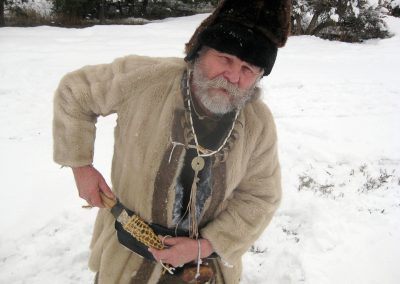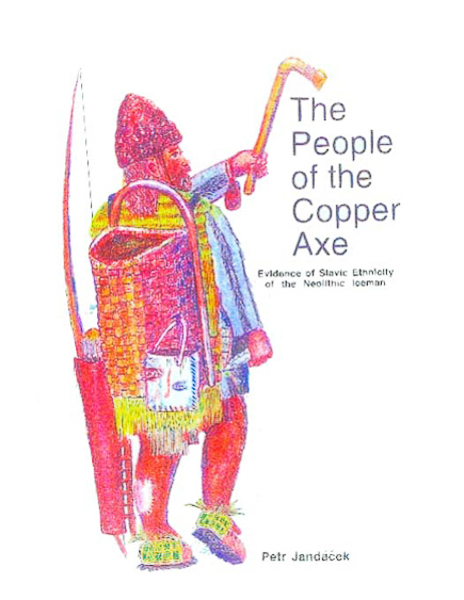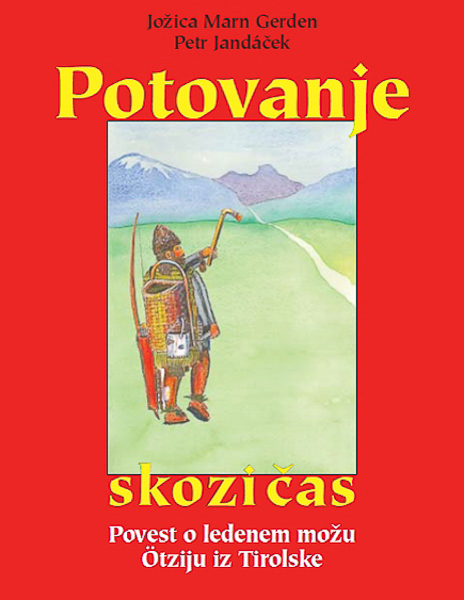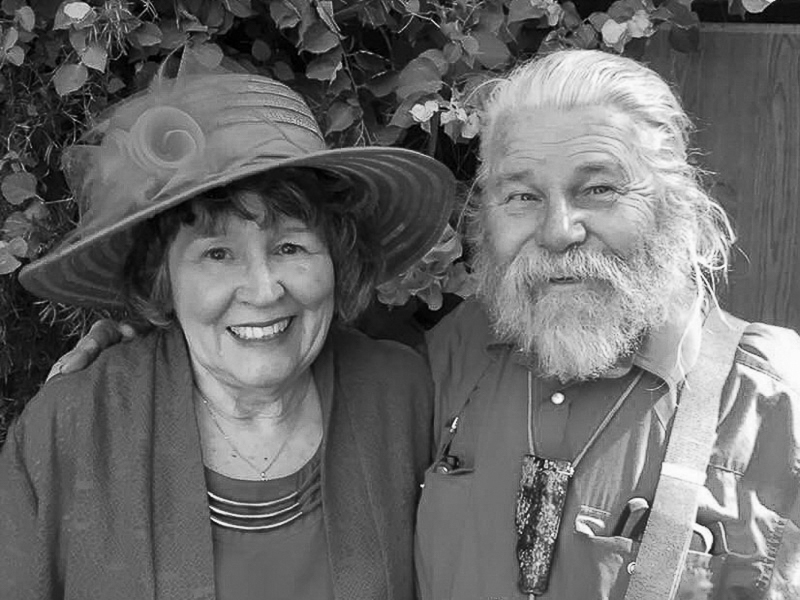
Ötzi the Iceman
Petr Jandacek’s character whom he impersonates most often is Ötzi, the Neolithic iceman of the Alps (The Iceman Talketh). Besides the standard information about the Neolithic/Chalcolithic coppersmith of 5.300 years ago, Petr also addresses domains about the life and death of the iceman which are not usually considered by the Ötziological Community. For instance:
- Why were all of the Iceman’s belongings DISPLAYED on stoney pedestals as in a store window?
- Why did the Iceman die with his left arm strangely stretched below his chin, and clutching a dagger in his right hand?
- How did the Iceman get the hole in his head?
- What sort of language was the Iceman likely to speak?
- Is it coincidental that many of the names of items which the Iceman had with him are similar in Basque and Slavic languages?
As The Iceman Talketh – Jandacek answers these questions in spoken and written word and with illustrations in a comic book.
The Iceman Talketh
The Copper Axe
Ötzi – 1/5th Scale Possessions
Ötzi 1/5 scale includes: poisonous mushrooms (for antibiotics), grass cape, shoes, twine, small tools of stone and bone in a pouch (also in the pouch were flints and pyrites for fire-kit), leggings similar to those worn by plains native peoples of North America, objects made from ibex bone and horn, bow, arrows, flint dagger and sheath, bearskin hat, stone amulet and tassel hanging from neck, breechcloth, retouching tool, quiver with arrows, barley and wheat grains, rucksack, sloe plums, two birchbark buckets, net, and well tailored coat.
- Ötzi the Iceman had with him BIRCH FUNGI which are poisonous. The TOXIN is an ANTIBIOTIC for cuts and scrapes, and very effective against TUBERCULOSIS. Note that the words POISON and POTION are of the same origin.
- The Basque word for POISON is EDEN the Czech is JED.
- Ötzi, had with him a CLOAK OF GRASS. GRASS is BELAR in Basque and BILINA in common Slavic.
- Ötzi had well made BOOTS or SHOES. A TWINE was tied around Ötzi’s feet and stuffed with grass for extra insulation. Many pieces of TWINE were found with the Iceman. TWINE is MATAZA in Basque and MOTOUZ in Czech.
- The Iceman had a breach cloth and LEGGINGS identical to the fashion of Native American Men 5,000 years later !!
- The SHOE TONGUES were not parts of the shoes, but parts of the LEGGINGS! TONGUE is HIZKUNTZA in Basque, JAZYK in Slavic.
- A tabernacle made from the HORN of the sacred IBEX housed the most valuable items used to generate new fire: iron pyrites, flint and flammable fungus. To GORE with horns is ADARKATU in Basque and OTRKATI in Czech.
- The Iceman’s BOW was over 6 ft long, while the man himself was under 5 and a half feet tall.
- The birch sap GLUE used to mount fletches and arrow heads is called KOLA in Basque and KLIH in Czech.
- The flint knife was SHARP. SHARP is ZORROTZ in Basque and OSTRO in Slavic languages. The knife had a macrame scabbard.
- A BEAR SKIN HAT was worn by Ötzi. Parts of BEAR, IBEX, MARBLE and the AXE are ancient symbols of authority.
- The Iceman had a CIRCULAR MARBLE BEAD strung around his neck. Such a DISK would be called a KORRUSHKA in Basque and KROUZHEK in Czech.
More About Ötzi
- Ötzi had with him a copper bladed AXE. An AXE is AIZKORA in Basque and SEKERA, SEKIRA, SEKYRA etc. in Slavic.
- The BODY PARTS of Ötzi have similar terminology in Basque and Slavic languages: Basque ZILBOT, Russian ZhIVOT is BELLY. Basque UKAI, Czech RUKA is HAND or FOREARM. BELAUNUE is Basque and KOLENO is Slavic for KNEE. They in turn are the root-words for GENERATION: BELAUNALDI & POKOLENI. In the groin area one finds MOTSHIN, similar in Basque and Slavic, and BARABIL in Basque and VARLE in Czech.
- The LIMB-LEG is HANKA in Basque and HNATA in Czech. ANKLE is orKATILa in Basque and KOTNIK in Czech.
- The Iceman had a RETOUCHER TOOL (a small wood-shafted implement. It looks like a stout pencil with the graphite core replaced with ELK ANTLER.) It is used to produce a very sharp edge on stone blades or to resharpen dull blades by pressure flaking along the edges. More of the antler core can be exposed just like sharpening a pencil.
- The Basque word for ELK is OREIN, Slavic is JELEN.
- The physical features of the man (from the back) have similar names in Basque and Slavic languages. BACK is atZeAlDE in Basque and ZADA in Czech. BUTTOCKS is IPURDI in Basque and PRDEL in Czech (vulgate).
- The numerous TATTOOS on the man are all in inconspicuous places and correspond to skeletal injuries and infirmities. Thus they were for therapy and not for display.
- Ötzi the Iceman had with him GRAIN which the Basques call ZITU and the Slavs call ZhITO.
- A QUIVER filled with arrows was found with Ötzi.
- The BACKPACK FRAME was made of hazelNUT WOOD. NUT is URRA in Basque and OREH, ORECH or ORAH in Slavic languages.
- The STICKS of WOOD for the BOW, ARROWS, AXE HANDLE, BACKPACK FRAME etc. are called OHOL in Basque and HOL or HUL in Czech.
- Two birch bark BUCKETS were found with Ötzi. BARK is called GERUZA in Basque and KURA in Czech. BUCKET is called BERTZ in Basque and DZhBER in Czech.(Basque orthography does not permit a word to start with more than a single consonant… hence the TZ is found on the end of the word.)
- One BERTZ-DZhBER contained BURNING COALS. BURNING is GORI in Basque and GORI in common Slavic. The hot coals were wrapped in leaves for insulation. LEAVES are called HOSTO in Basque and LISTI in Czech.
- RIPE SLOE PLUMS were found with Ötzi. RIPE is an important word to hunters and Gatherers. The process is called ZORITU in Basque, ZORITI in Slovenian and ZRATI in Czech.
- A NET for fishing and fowling was found with Ötzi.
- Beautifully tailored FUR COAT was found with Ötzi. COAT is called GABAN in Basque and KABAT in Czech.
- The coat was PATCHED over a tear. PATCH is CHAPLATA in Basque and ZAPLATA in Slavic languages. SKIN in Basque is called GERUZA and KOZhA in Slavic.
- When the hair or fur is removed from the skin the result is BARE, NAKED, STRIPPED, HAIRLESS, etc. This condition is described as GORRI in Basque and HOLI or GOL in Slavic.
- In the vicinity of the Iceman we find ELEVATED PLACES which the Basques call GORA, and the Slavs call GORA.
- We find STREAMS which the Basques call ERREKA and the Slavs call REKA. We also find a LAKE which the Basques call ZINGIRA and the Slavs call JEZERO.
- Petr Jandacek wishes to point out that stone age hunters and gatherers had few things, and few things to talk about. Yet almost all that they had has similar names in Basque and Slavic languages to this day. Candor dictates that Jandacek confesses that he has had almost no success in convincing the linguistic or anthropological community that in antiquity the ancestors of Basques and Slavs could understand each other.
- The last day of Ötzi’s trip he was surrounded by land features which have similar names in BASQUE and SLAVIC languages. ELEVATION or MOUNTAIN is GORA in Basque.
- ELEVATION or MOUNTAIN is GORA in Slavic.
- STREAM is ERREKA in Basque.
- STREAM is REKA in Slavic.
- LAKE is ZINGIRA in Basque.
- LAKE is JEZERO in Slavic.
- From archaeological record we know that Ötzi and his people practiced agriculture. Words dealing with farming are similar in Basque and Slavic languages.
- BEYCHKA is the Basque word for a HEIFER.
- BEYTCHEK is the Czech word for a BULLOCK.
- SERRI is the Basque word for PIG.
- SELE is the Czech word for PIG
- URATU is the Basque word for PLOWING.
- ORATI is the Slavic word for PLOWING.
- ZITU is the Basque word for GRAIN.
- ZhITO is the Slavic word for GRAIN.
- ZIZARE is the Basque word for EarthWORM.
- ZhIZhALA is the Czech word for EarthWORM.
- ARABI is the Basque word for CRANBERRY.
- JERABINA is the Czech word for CRANBERRY.
- GERABI is the Basque word for HOIST or CRANE.
- JERAB is the Czech word for HOIST or CRANE.
- ZAPO is the Basque word for FROG.
- ZhABA is the Slavic word for FROG.
- (Notice that many items above are are associated with WETLANDS agriculture).
- TCHANEL is the Basque word for SMALL BOAT. TCHLUN, TCHUN, TCHLN, TCHOLN are some of the Slavic forms.
- HUMAN + GOAT + FLUTE = DEMON
- WOOD-WIND (or more specifically BONE-wind) instruments date back to the palaeolithic and are associated not only with the Cro Magnon but also with the Neanderthal People of more than 30, 000 years ago.
- GOAT-SKINS have been used in antiquity for water vessels and BELLOWS. GOAT-SKIN bellows were needed for the smelting of copper for Ötzi’s axe-head. Ötzi had with him at least 3 parts of an ibex goat.
- It is a natural step to combine a wood-wind musical instrument with goat-skin bellows and come up with a type of bag-pipes. The Basques call this instrument GAITA.
- Such instrument is also used by Slovaks and their neighbors (Ruthenians, Czechs & Guralu Poles) who call it GAJDA. Creatures possessing HUMAN & GOAT CHARACTERISTICS & PLAYING WOOD-WIND INSTRUMENTS have been depicted on walls of caves more than 25,000 years ago.
- Ostensibly, a GAITA-GAJDA has a breath of life and demonic-capricious yodel voice. A DEMON with HUMAN-GOAT features is called a TCHEREN in Basque, and TCHERT or TCHYORT in Slavic languages. His mischief is called TCHARTO In Basque and TCHERTITI or TCHERTOVATI in Slavic. In Greek this Goat-Man is SATYR and PAN who caused PANic with the sounds of his PAN-pipes. (Capricious as in Capricorn means Goat-like). The above facts help us speculate about Ötzi’s SPIRITUAL ASPIRATIONS.
Download Books
(505) 672-9562
Petr Jandacek
Louise Jandacek
Mailing Address
127 La Senda Road
Los Alamos, New Mexico
USA
87544

